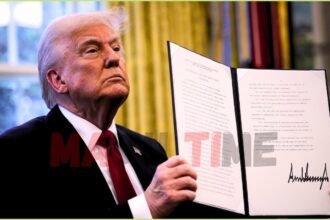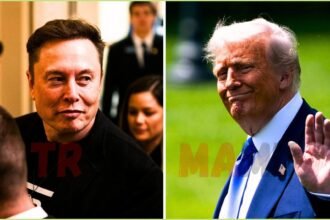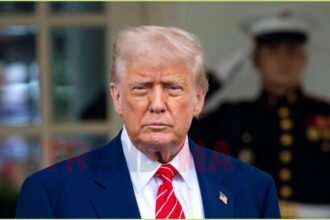Trump Slaps 25% tariffs on Japan and South Korea goods starting August 1, citing trade imbalances. Explore the economic and geopolitical impacts!
President Donald Trump has reignited his trade war with a bold move, announcing a 25% tariff on goods imported from Japan and South Korea, two of America’s key allies in Asia. The decision, revealed on Monday, July 7, 2025, through letters posted on Truth Social, targets persistent trade imbalances and sets the stage for a high-stakes economic showdown.
Effective August 1, the tariffs could reshape global trade dynamics, particularly in the auto and electronics sectors, while straining diplomatic ties with Tokyo and Seoul. Trump’s letters to Japanese Prime Minister Shigeru Ishiba and South Korean President Lee Jae-myung warned against retaliatory measures, hinting at further increases if the countries respond with their own tariffs.
As the world watches, this latest chapter in Trump’s tariff saga underscores his commitment to an America-first trade policy, but it also raises questions about the economic and geopolitical fallout. Here’s a deeper look at the tariffs, their implications, and the broader context of Trump’s trade strategy.
A Bold Move to Address Trade Imbalances
President Trump’s decision to impose 25% tariffs on Japan and South Korea stems from his long-standing frustration with trade deficits. In 2024, the U.S. recorded a $68.5 billion goods deficit with Japan and a $66 billion deficit with South Korea, according to the Office of the United States Trade Representative.
Trump views these imbalances as evidence that the U.S. is being shortchanged by its trading partners, a perspective he has championed since his first term. The tariffs, set to begin on August 1, 2025, are designed to pressure Japan and South Korea into renegotiating trade terms to favor American businesses and workers.
The announcement came via letters posted on Trump’s Truth Social platform, addressed to Japanese Prime Minister Shigeru Ishiba and South Korean President Lee Jae-myung. Written in Trump’s distinctive style, the letters blend formality with his characteristic flair, capitalizing phrases like “Number One Market in the World” and inviting both nations to “participate in the extraordinary Economy of the United States.
” The tariffs, described as “separate from all Sectoral Tariffs,” will apply to most goods but won’t stack on top of existing duties on industries like autos or steel, according to White House officials.
Trump’s letters also carried a stern warning: if Japan or South Korea retaliate by raising their own tariffs, the U.S. will increase its rates by an equal amount. “If for any reason you decide to raise your Tariffs, then, whatever the number you choose to raise them by, will be added onto the 25 per cent that we charge,” Trump wrote.
This tit-for-tat threat underscores his aggressive approach to trade negotiations, aiming to deter counter-measures that could harm American exports. The letters further noted that goods transshipped through third countries to evade tariffs would face the higher rates, signaling Trump’s intent to close loopholes.
Economic and Geopolitical Risks
The tariffs pose significant risks for Japan and South Korea, whose economies rely heavily on exports to the U.S. Japan, the fifth-largest supplier of U.S. imports, sent $148 billion in goods last year, while South Korea, ranked seventh, shipped $132 billion, according to U.S. trade data.
Key exports like cars, auto parts, semiconductors, and electronics could face higher costs, potentially leading to price hikes for American consumers or reduced profits for Asian manufacturers.
For example, Japanese automakers Toyota, Nissan, and Honda saw their U.S.-listed shares drop by 4%, 7.2%, and 3.9%, respectively, after the announcement, reflecting market concerns about the tariffs’ impact.
South Korea’s technology sector, including companies like LG Display and SK Telecom , also took a hit, with shares falling 8.3% and 7.8%. The tariffs could disrupt global supply chains, particularly for semiconductors, where Malaysia and South Korea are major suppliers to the U.S. American businesses, which pay the tariffs, may pass costs onto consumers, potentially fueling inflation—a concern already on the Federal Reserve’s radar as it holds interest rates steady to monitor tariff-driven price pressures.
Geopolitically, the tariffs strain relations with two critical U.S. allies in countering China’s influence in Asia. Japan and South Korea cooperate with the U.S. on economic security, including semiconductors and critical minerals, and have made significant manufacturing investments in America. Wendy Cutler, vice president of the Asia Society Policy Institute, called the move “disappointing” but noted there’s still time for negotiations, given the August 1 start date.
South Korea’s Industry Ministry said it would “step up negotiations” to reach a “mutually beneficial result,” while Japan’s embassy in Washington offered no immediate comment.
Trump’s letters suggested a way out: no tariffs would apply if companies from Japan or South Korea build manufacturing facilities in the U.S., with approvals promised “quickly, professionally, and routinely.” This aligns with his goal of boosting domestic production, but critics argue it overlooks the complexities of relocating supply chains and could alienate allies at a time when unity against China is crucial.
Part of a Broader Tariff Strategy
The tariffs on Japan and South Korea are just one piece of Trump’s ambitious trade agenda, which has seen him target multiple countries since his second term began in January 2025. On April 2, dubbed “Liberation Day,” Trump announced reciprocal tariffs as high as 50% on dozens of nations, including 24% on Japan and 25% on South Korea. After a global market crash, he paused these rates, capping them at 10% for 90 days to allow negotiations.
The August 1 deadline extends this pause, giving countries like Japan and South Korea three more weeks to strike deals.On Monday, Trump also sent tariff letters to 12 other countries, including Malaysia, Kazakhstan, South Africa, Myanmar, Laos, Thailand, Cambodia, Serbia, Bangladesh, Indonesia, Bosnia and Herzegovina, and Tunisia, with rates ranging from 25% to 40%. White House press secretary Karoline Leavitt said more letters could follow, emphasizing Trump’s goal of “tailor-made trade plans for each and every country.
” So far, only three deals have been reached—with the UK, Vietnam, and a partial agreement with China—raising concerns about the feasibility of negotiating scores of agreements.Trump’s tariffs are enabled by the International Emergency Economic Powers Act (IEEPA), though their legality is under court review.
He has also used Section 232 of the Trade Expansion Act to impose 50% tariffs on steel and aluminum and 25% on autos, with investigations underway for pharmaceuticals and copper. Critics, including economist Peter Schiff, warn that tariffs will raise consumer prices and isolate the U.S. from allies, while supporters argue they protect American industries and leverage trade negotiations.
Markets reacted negatively, with the S&P 500 falling 0.8% and the Dow Jones Industrial Average dropping nearly 500 points on Monday. Investors worry about inflation and economic slowdown, though Treasury Secretary Scott Bessent predicted more trade announcements soon, suggesting a flurry of activity before August 1. Trump’s reliance on tariff revenue to offset recent tax cuts adds another layer of complexity, potentially shifting the tax burden to middle-class consumers.
In conclusion,
President Trump’s 25% tariffs on Japan and South Korea mark a dramatic escalation in his trade war, aimed at correcting trade imbalances but risking economic and diplomatic fallout. With warnings against retaliation and an offer to waive tariffs for U.S.-based manufacturing, Trump is betting on his hardline approach to reshape global trade.
As the August 1 deadline looms, the world awaits the next moves in this high-stakes economic drama, with Japan, South Korea, and other nations under pressure to respond. Whether this strategy strengthens America’s economy or isolates it from allies remains to be seen, but one thing is clear: Trump’s tariffs are keeping the global stage on edge.









